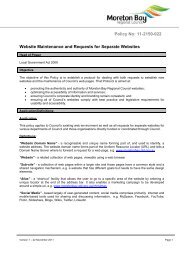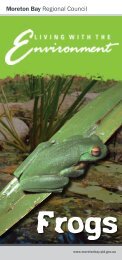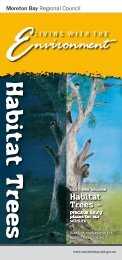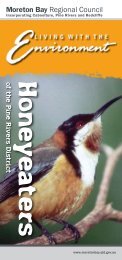South East Queensland Ecological Restoration Framework: Manual
South East Queensland Ecological Restoration Framework: Manual
South East Queensland Ecological Restoration Framework: Manual
Create successful ePaper yourself
Turn your PDF publications into a flip-book with our unique Google optimized e-Paper software.
5.3.5 Chemical mixing rates<br />
Herbicides and additives are generally mixed with water and the rate the herbicide is mixed is<br />
expressed as a ratio of herbicide to water – e.g. 1:100 would mean one part herbicide to 100 parts<br />
water. The higher the number used to describe the water component, the weaker the dilution. So 1:50<br />
is a much stronger mix than 1:200. A mix of 1:1 (as used for cut-scrape-paint) would be equal parts of<br />
herbicide and water.<br />
The advantage of using ratios means that calculations can be made for the correct dilution for any size<br />
spray unit (from a knapsack through to a power sprayer) to obtain the rate that you require.<br />
When mixing a 10L knapsack for over-spraying or spot-spraying, the following quantities of herbicide<br />
would be added in order to obtain the correct dilution:<br />
Table 3. Guide to equate herbicide volumes with ratios.<br />
ratio<br />
1:50 200mL<br />
1:100 100mL<br />
1:200 50mL<br />
quantity of<br />
herbicide in<br />
10L water<br />
5.3.6 Weed control equipment<br />
Note, for products such as metsulfuron methyl that are<br />
granular substances, these dilution rates do not apply.<br />
Instead, they must be weighed (usually 1g to 1.5g is required<br />
for a 10L pack) and dissolved in water before adding to the<br />
knapsack.<br />
The chemical application rates for some of the more<br />
commonly encountered environmental weeds are presented<br />
in Appendix C.<br />
Care must be taken to avoid transporting weed seeds and plant diseases from one restoration site to<br />
another via vehicles, tools, equipment and boots.<br />
A vehicle washdown area, located at the works depot provides an adequate facility for hosing down<br />
vehicles to remove mud and sand (and the seeds that adhere).<br />
To reduce the possibility of introducing plant diseases and weeds from one site to another the<br />
following measures should be applied between sites:<br />
• Secateurs to be sharp and cleaned with methylated spirits; and<br />
• Footwear to be cleaned of loose soil and preferably treated with bleach using a spray bottle or<br />
foot bath.<br />
Take some time to consider this issue – you certainly don’t want to be responsible for inadvertently<br />
introducing a serious environmental weed or disease into an area where it will cause a great deal of<br />
damage.<br />
5.3.7 Tools used in ecological restoration<br />
Personal Protective Equipment (PPE)<br />
Appropriate PPE should be worn during ecological restoration activities. The MSDS includes information<br />
about the most appropriate PPE when using specific herbicides.<br />
Knapsack<br />
A 15 litre knapsack spray unit is used for spot-spraying weeds close to the ground or over-spraying large<br />
expanses of weeds such as lantana. Usually an adjustable nozzle will need to be purchased separately<br />
as the fan-shaped nozzle that is supplied with the knapsack is not appropriate for spot-spraying in<br />
areas of natural vegetation. The nozzle can be adjusted to widen the flow of herbicide (to allow good<br />
coverage over soft annual weeds close to the ground) or narrow the flow of herbicide under high<br />
pressure (to project long distances over a large patch of lantana). When working in steep, slippery or<br />
otherwise hazardous terrain it is advisable to only-fill the knapsack to 10 litres.<br />
SEQ <strong>Restoration</strong> <strong>Framework</strong><br />
100<br />
MANUAL


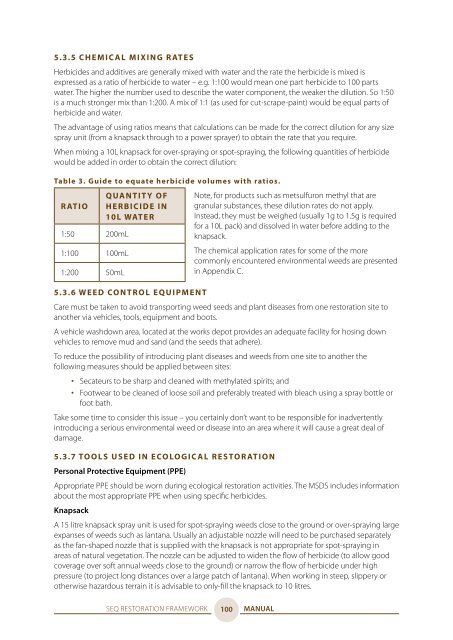
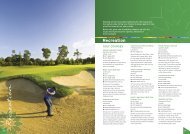

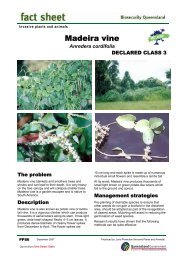
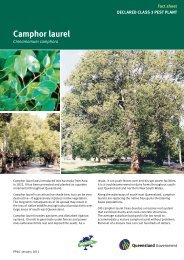


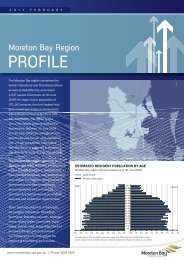
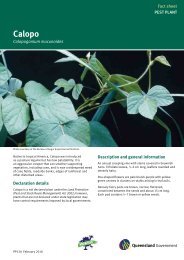

![Kumbartcho Brochure [PDF 540KB] - Moreton Bay Regional Council](https://img.yumpu.com/47220970/1/190x101/kumbartcho-brochure-pdf-540kb-moreton-bay-regional-council.jpg?quality=85)
